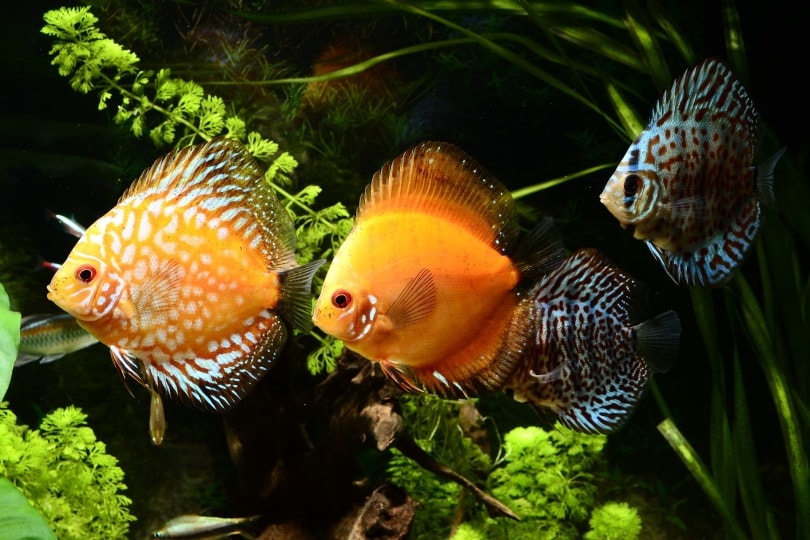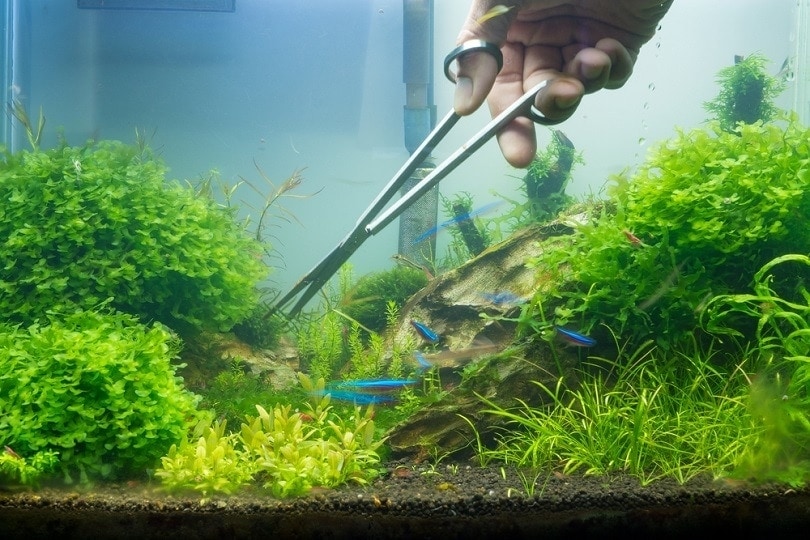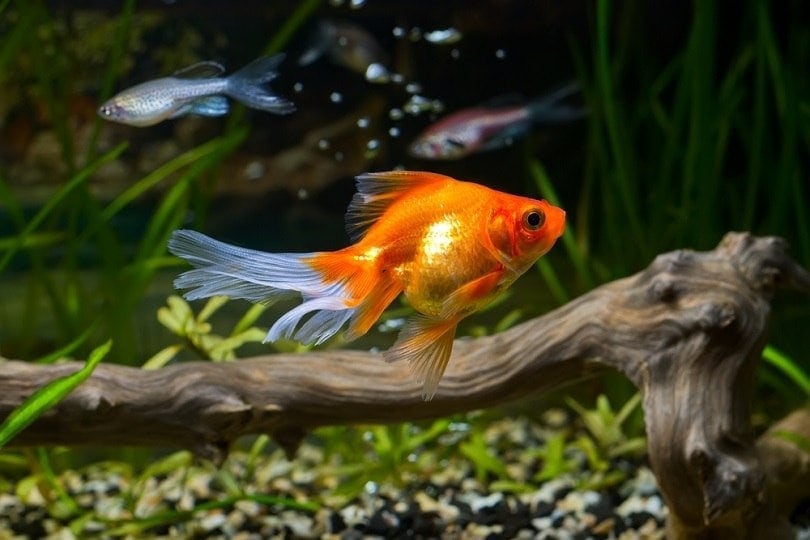Danio Fish: Care Guide, Types, Lifespan & More (With Pictures)

Updated on
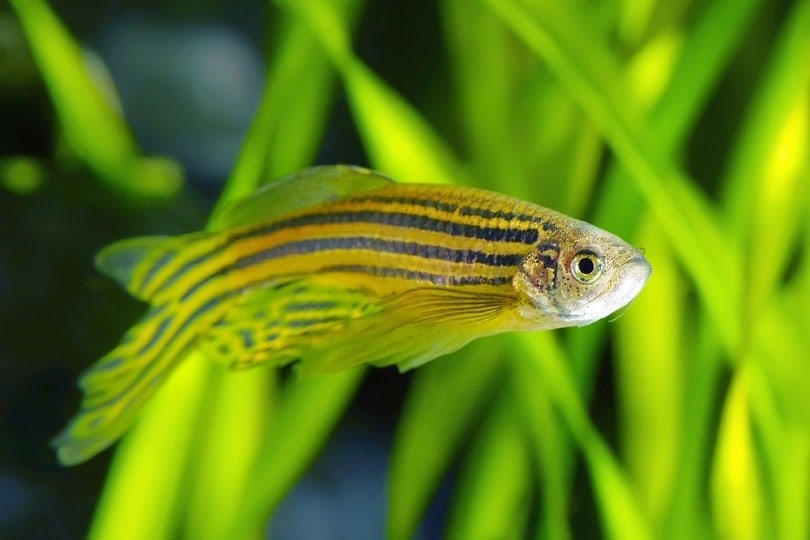
You’ve likely spotted danio fish darting around the aquariums at pet stores, but you may not realize that the fish are great for beginners. Danios tend to be hardy and easy to care for, and they come in multiple colors and varieties that can each add its own unique touch to your aquarium. If you’ve been interested in learning more about danio fish, keep reading!
Quick Facts About Danio Fish
| Species Name: | Danio |
| Family: | Cyprinidae |
| Care Level: | Easy |
| Temperature: | 70–80°F |
| Temperament: | Peaceful |
| Color Form: | Blue and silver stripes, albino, GloFish morphs |
| Lifespan: | 3–5 years |
| Size: | 2 inches |
| Diet: | Omnivorous |
| Minimum Tank Size: | 10 gallons |
| Tank Set-Up: | Tropical freshwater tanks |
| Compatibility: | Other peaceful fish |
Danio Fish Overview
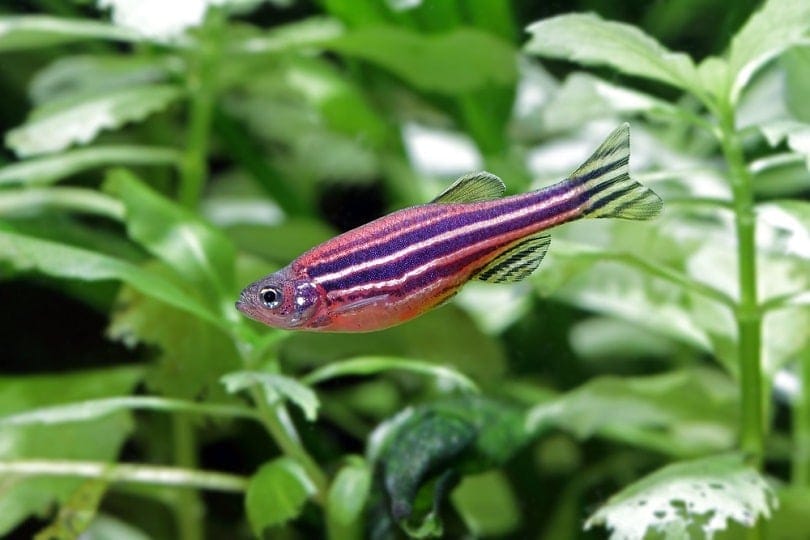
These playful fish are perfect additions to tropical community tanks with other fish that are similar in size and temperament to danio fish. Danios are curious and demonstrate a social hierarchy of sorts within their shoals. They are best kept in groups of at least six fish, but 10 or more is ideal. Multiple types of danios, including zebrafish, pearl danios, spotted danios, and rosy danios, are rising in popularity.
Other fish that you may not realize are danios are galaxy rasboras, which are also called celestial pearl danios and emerald dwarf rasboras. You also may notice neon-colored danios in the GloFish tanks at your local pet store, which are usually specially bred zebrafish.
Since they’re popular for their good looks, playfulness, and hardiness, danio fish are widely available, making them easy to add to your aquarium. Community tanks are a great place for danio fish because they bring action and liveliness to the tank without adding aggression and the fear of other fish being eaten. However, they will eat other animals they can fit in their mouth, which includes shrimplets and small fry.
How Much Do Danio Fish Cost?
Danio fish are inexpensive fish, usually costing between $1–$6 per fish. They are shoaling fish, so it’s ideal to keep them with other danio fish, and you’ll likely spend $6–$40 to take home multiple fish. The main cost associated with bringing danios home is everything needed for their tank.
A 10-gallon aquarium with a filter and all other necessary equipment can cost you anywhere from $15–$100. You’ll also need to purchase plants and tank décor, which can cost up to $50 or so, and high-quality food, which will be $5–$15.
Typical Behavior & Temperament
Danio fish are peaceful, shoaling fish, and they make wonderful additions to community tanks. Unlike many fish, they don’t usually stay in one level of the tank, and you may see them playfully chasing each other around at any tank level.
They are playful and social fish, but they are known for chasing and nipping at each other, so keep an eye on this behavior in case it leads to bullying and stress in your fish.
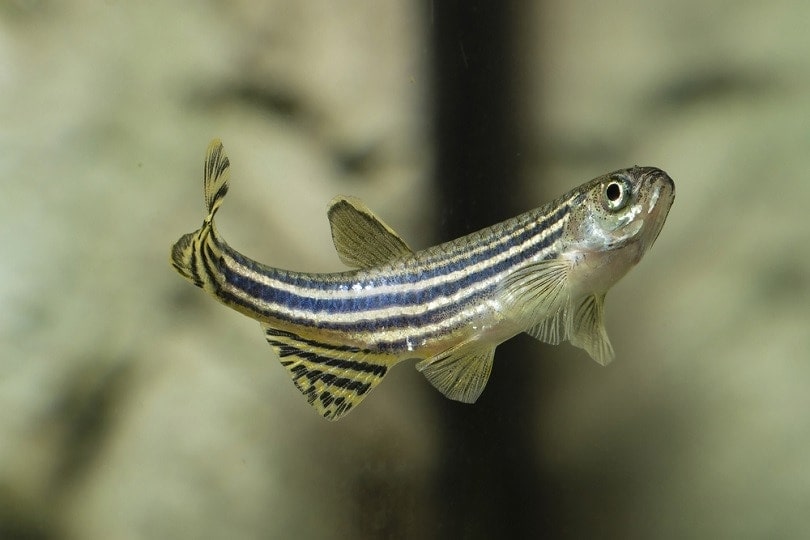
Appearance & Varieties
- Zebrafish: As the most commonly seen danio, zebrafish have horizontal blue and silver stripes running the length of their bodies. They also have horizontal stripes along their fins. Some of these fish have been specially bred to produce neon coloration, and you may see brightly-colored zebrafish in the GloFish tanks.
- Pearl Danios: These fish have iridescent, pearlescent bodies that shimmer with blues and purples. They have a horizontal stripe that runs the length of the body that is typically orange or red. There is a variant of this variety of danio that has a yellow coloration and is called the yellow danio.
- Celestial Pearl Danios: Also known as galaxy rasboras, these fish have dark bodies with orange to red fins and white spots on their bodies. Their colors can be vivid, but this is usually around breeding time or when they’re extra happy. Don’t be surprised if your CPD doesn’t retain vivid colors year-round.
- Rosy Danios: These danios are similar in appearance to pearl danios, but they lack the horizontal stripe. Usually, the body is iridescent purple and blue with a rose-colored area along the lower portion of the body.
- Emerald Dwarf Rasboras: These unique-looking fish have blue bodies with vertical, pointed stripes along the length of their bodies. The stripes are usually tan to brown but can also be yellow or gold. They have a small dark area at the base of the tail fin and orange or red coloration on the cheeks and fins. They are similar to CPD in that their vivid colors may not stay all the time, but their markings will not change.
How to Take Care of Danio Fish
Habitat, Tank Conditions & Setup
Aquarium Size
Danios can be kept in aquariums as small as 10 gallons, but the larger, the better. They prefer tanks that provide a lot of swimming space, like rectangular tanks. Large cube-shaped tanks may also work well for your danios.
Water Temperature & pH
Danio fish are tropical fish, but they can live in water temperatures from 65–80°F. They prefer slightly warmer temperatures, though, so ideally, they should be kept at least at 73°F. They prefer a slightly acidic to neutral pH, with most danios preferring a pH from 6.5–7.0. Some danios can tolerate the water pH as low as 6.0.
Substrate
The substrate you choose for your danios isn’t of any particular importance, but they need a well-planted tank. Your substrate should be able to hold plants in place and allow them space to grow, so plant-specific substrates. Sand or small gravel are good options.
Plants
These fish love a well-planted tank. Since they live at all levels of the water column, you’ll need to provide plants of varying heights. Vallisneria, rotala, Amazon sword, and water wisteria are all good tall plant options.
Java fern, aponogeton, dwarf lilies, and Anubias are also great options for medium to tall plants. Anubias nana, dwarf hairgrass, and mosses are all good choices for carpeting and short plants. Floating plants, like red root floaters and dwarf water lettuce, are good additions due to their long, trailing roots.
Lighting
Danios are most active at night, so it’s a good idea to invest in a light that allows for day/night lighting. Medium lighting during the day should be fine for your danios, but bright light is acceptable if they have plenty of plants to shelter in. Blue “night” lighting will allow you to see your danios at their most active.
Filtration
As long as your filter provides oxygenation, aeration, and water flow, it should work for your danios. They have a relatively low bioload, and they don’t need an overly powerful filter. Keep in mind that they are small and can get sucked into filters that are too powerful.
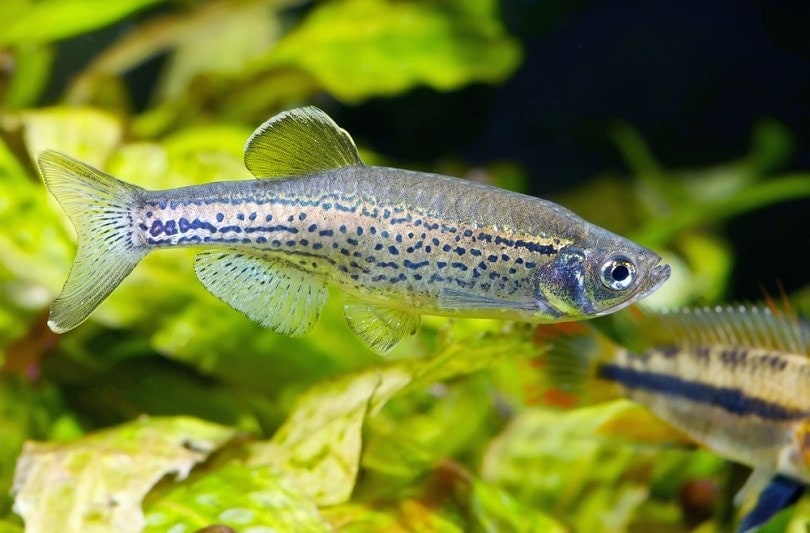
Are Danio Fish Good Tank Mates?
Due to their social nature, danio fish make great tank mates to other peaceful fish of similar size and nature. Beware of pairing your danios with livebearers, like guppies and mollies, because they may eat the newborn fry. It’s a good idea to avoid keeping your danios in a tank with fish that are territorial about their space in the water column since danios will go through the different water column levels at will.
Always quarantine new fish for at least a week before adding them to your main tank. This will allow you to monitor them for any health problems before introducing them to your other fish. Once introduced to your main tank, you’ll need to watch everyone closely while they adjust. Your danios may turn to fin nipping, especially if stressed, so provide them a low-stress environment as they adjust.
What to Feed Your Danio Fish
Danio fish are omnivorous, and their diet should reflect this. In the wild, danios eat small crustaceans and insects, like shrimp and mosquito larvae. They will eat some plant matter as well but generally aren’t going to go after your aquatic plants if they’re well-fed.
Provide your danios with a diet consisting of a high-quality flake or pellet for omnivores. This should be the base of their diet. You can also feed them gel foods for community fish. Your danios can be fed live or frozen foods as a treat, but they shouldn’t receive these foods multiple times per week.
These foods can be bloodworms, brine shrimp, mosquito larvae, and other similar items. You can offer fresh fruits and veggies to your danios as treats as well, like butternut squash and spinach.
Keeping Your Danio Fish Healthy
Danios are extremely hardy fish, and keeping them healthy should be a breeze if you are providing them with a healthy environment. Routine water changes, monitoring and correcting water parameters, a healthy diet, and a low-stress home will all help keep your danios healthy.
They are still susceptible to common aquarium diseases, like ich, velvet, and gill disease. Many common diseases are directly linked to poor water quality, so keeping up the water quality is your best prevention. If your danios do get sick, check their symptoms closely so you can determine how best to treat them. If you’re unsure, check with your aquatic or agricultural vet.
Breeding
Danios are egg scatterers that breed readily when kept happy and healthy. However, they are known to eat their eggs, and if the eggs manage to hatch, they will happily eat the hatchling fry. Providing plants for eggs and fry to hide in will improve your successful breeding efforts. A substrate that allows the eggs to safely fall in the cracks, like pebbles or marbles, works well if you’re hoping to breed your danios.
You can put a male and female into a breeding tank together and allow them to spawn, moving the parents back to the main tank once spawning has occurred. If you don’t have the ability to do this, just make your tank more breeding-friendly with plenty of places for the eggs to go safely.
Are Danio Fish Suitable For Your Aquarium?
Danios are wonderful, easy-care fish that make great additions to a community tank. Their playful nature and bright coloration make them fun to watch, and their social behavior is unusual and interesting. If you’re interested in keeping a warm community tank with other peaceful fish, danios would be perfect for your tank.
Other danios, minnows, and tetras are good tank mate options for danios, as well as large invertebrates like snails and large shrimp. Their life expectancy of up to 5 years means they are a commitment, and even though they are hardy, they still require time and care. If this commitment is one you’re willing to make, you won’t be disappointed by danio fish.
Related Reads:
Featured Image Credit: Grigorev Mikhail, Shutterstock




